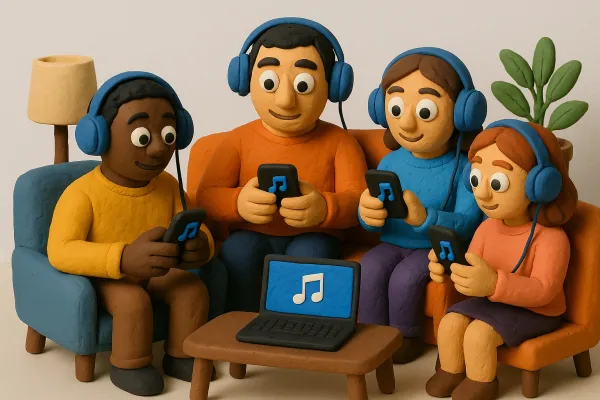Unlocking Success: How to Get Your Music Heard in a Crowded Market

Getting your music heard in today's crowded market can feel like shouting into a void. With so many artists competing for attention, it’s easy to feel lost. But don’t worry—there are practical steps you can take to stand out. From understanding streaming platforms to connecting with fans and using data wisely, this guide will help you navigate the music world and get your sound in front of the right people.
Key Takeaways
- Focus on optimizing your music for streaming platforms to work with their algorithms.
- Build meaningful connections with your audience through social media and exclusive content.
- Collaborate with other artists to reach new listeners and expand your fanbase.
- Use listener data to make informed decisions about releases and promotions.
- Develop a consistent release schedule to keep your audience engaged and excited.
Mastering Streaming Platforms for Maximum Reach
Optimizing Your Music for Algorithms
Let’s face it, algorithms practically run the show on streaming platforms. They decide whether your track gets looped into someone’s daily mix or buried under a mountain of other songs. The trick? Create tracks that both humans and algorithms can’t ignore. Think catchy hooks, strong intros, and a polished sound. If the first 30 seconds of your song don’t grab attention, the algorithm might move on—and so will listeners.
Here’s a quick checklist to make your music algorithm-friendly:
- Strong intros: Hook your listener within the first 10-30 seconds.
- Consistent releases: Algorithms love artists who upload regularly.
- Metadata matters: Make sure your song titles, descriptions, and tags are accurate and relevant.
Pitching to Editorial Playlists
Editorial playlists are like the holy grail of streaming success. Getting on one can skyrocket your streams overnight. But here’s the thing—it’s not just about sending your track and crossing your fingers. You’ve got to pitch it right. Use your streaming platform’s submission tools (like Spotify for Artists) and tell a story about your song. What’s the vibe? Who’s it for? Why should it be featured?
Pro tip: Timing is everything. Submit your track at least 4 weeks before its release date to give curators enough time to consider it.
Leveraging User-Generated Playlists
Don’t underestimate the power of DIY playlists created by everyday users. These playlists can have thousands—even millions—of followers. Reach out to playlist creators directly, but keep it personal. Nobody likes a generic copy-paste message.
Here’s how to approach them:
- Find playlists that match your genre or vibe.
- Listen to the playlist and make sure your music fits.
- Send a polite, personalized message explaining why your song is a great match.
Streaming platforms are a game-changer for indie musicians. But success doesn’t just happen—you’ve got to work the system, stay consistent, and always keep learning. It’s a marathon, not a sprint.
Building a Loyal Fanbase Through Engagement
Connecting on Social Media
We all know social media is where everyone hangs out these days. Platforms like Instagram, TikTok, and Twitter? That’s the new backstage. The key is showing up consistently and being real. Share behind-the-scenes clips, sneak peeks of your songs, or even goofy moments from your day. And don’t just post and ghost—reply to comments, start conversations, and actually care about what your fans are saying. It’s not about being perfect; it’s about being relatable.
Hosting Live Listening Parties
Ever thought about throwing a listening party? It’s like inviting your fans to your living room—except it’s online. Pick a date, hype it up on your socials, and go live on platforms like Twitch or Instagram. Play your latest track, share fun stories about how it came to life, and answer questions in real time. It’s not just about playing music; it’s about creating a moment. Plus, fans love feeling like they’re part of something exclusive.
Creating Exclusive Content for Fans
Fans love getting the VIP treatment. Think about offering things like:
- Early access to your new singles.
- Behind-the-scenes videos from the studio.
- Personalized shoutouts or messages.
These little extras make your fans feel like they’re in on something special. You could even create a members-only group or mailing list where they get first dibs on everything. It’s all about making them feel like they’re part of your inner circle.
Building a fanbase isn’t just about the music—it’s about the connection. When fans feel seen and appreciated, they’re not just listeners; they’re part of your journey.
Collaborating to Expand Your Audience
Partnering with Other Artists
When we team up with other artists, it’s like combining forces to create something bigger than ourselves. Think about it: their fans get to discover your music, and vice versa. A great way to start is by featuring each other on tracks or even creating a joint project. Another option? Curate a shared playlist. This can spotlight both of your sounds and give listeners a reason to keep coming back. And let’s not forget live performances—co-headlining a show can be a total game-changer. The best part? You’re not just growing your audience; you’re building relationships that could lead to even more opportunities.
Exploring Cross-Genre Collaborations
Stepping outside your usual genre might seem risky, but trust us, it’s worth it. Collaborating with artists from different styles can bring fresh energy to your music. Picture a country singer teaming up with a hip-hop artist or an indie band working with an electronic producer. The mix of sounds can create something totally unique. Plus, it exposes you to a whole new audience that might not have found you otherwise. Don’t be afraid to experiment—you never know what kind of magic you’ll create.
Tapping into International Markets
The world is huge, and there’s no reason to limit yourself to just one corner of it. By working with international artists, you can tap into their fanbase and introduce your music to listeners halfway across the globe. This isn’t just about recording a song together—it’s about blending styles and creating something that feels fresh and exciting. Take the time to understand their audience and adapt your approach. Whether it’s singing in another language or incorporating local sounds, these collaborations can open doors you didn’t even know existed. Collaborating with artists from various genres isn’t just fun; it’s a smart way to grow.
Crafting a Data-Driven Music Strategy
Understanding Listener Analytics
Numbers might not sound like the most exciting part of music, but they're the secret sauce to growing your audience. When we dig into listener analytics, we uncover a goldmine of info about who's tuning in and how they're engaging with our tracks. Here's what we should focus on:
- Demographics: Are our fans teenagers in Tokyo or 30-somethings in Texas? Knowing their age, gender, and location can help us connect better.
- Listening Habits: Do our listeners vibe with our music during their morning jogs, or are they night owls? This can guide when to drop new tracks.
- Engagement: Which songs are they loving and which ones are they skipping? This helps us figure out what’s working—and what’s not.
Adjusting Campaigns Based on Insights
So, we’ve got the data—now what? It’s time to tweak our approach. Here’s how:
- Tailor Content: If we see a spike in listeners from Brazil, maybe it’s time to record a Portuguese version of a hit song.
- Time It Right: Use the data to figure out the best times to release new music or post updates.
- Experiment: If something isn’t clicking, don’t be afraid to try something new. Switch up your style, your visuals, or even your messaging.
Data isn’t just numbers—it’s a story about how people connect with our music. The better we understand it, the better we can grow.
Timing Your Releases for Maximum Impact
Timing really is everything. With the right data, we can pinpoint the perfect moment to release new tracks. Think about these:
- Seasonal Trends: Are our songs better suited for summer road trips or cozy winter nights?
- Fan Activity: If our analytics show our fans are most active on Friday evenings, that’s when we should launch.
- Industry Patterns: Keep an eye on big releases. Dropping our song the same day as a major artist might not be the best move.
By keeping an eye on listener behavior and adjusting our strategy, we can make sure our music gets the attention it deserves. And remember, every stream, every playlist add, and every fan gained brings us closer to making our mark.
Making Your Music Stand Out Globally
Localizing Your Content for Different Cultures
If we want our music to connect with people worldwide, we’ve got to make it feel like it belongs wherever it’s heard. This isn’t just about translating lyrics (though that’s a good start). Think about creating lyric videos in multiple languages, tweaking your song titles to fit local vibes, or even adjusting your cover art to appeal to specific regions. It’s about speaking your audience’s language—both literally and culturally.
Here’s what we can do:
- Translate song titles and descriptions into popular languages like Spanish, French, or Mandarin.
- Create region-specific promotional campaigns that highlight your music’s relevance to local listeners.
- Consider re-recording a track with lyrics that reflect the culture or experiences of a particular audience.
Exploring Emerging Music Markets
There’s so much happening in music scenes across the globe, and some regions are just exploding with opportunity. Latin America, K-Pop hotspots, and Afrobeats territories are great examples. We should dig into our analytics to see where our music is already catching on and focus our efforts there.
Some ideas include:
- Collaborating with artists from these regions to tap into their fanbases.
- Running targeted ads or campaigns specifically for these markets.
- Learning about the local music trends and incorporating some of those elements into our sound.
Collaborating with International Artists
Teaming up with artists from other countries is one of the coolest ways to expand our reach. It’s not just about blending musical styles—it’s about blending fanbases. When we work with someone who has an established audience in a different part of the world, we’re opening the door to so many new listeners.
Some tips for making this happen:
- Reach out to artists whose work we admire and who have a sound that complements ours.
- Be open to experimenting with different genres or styles that might be new to us.
- Use social media or platforms like Spotify to find potential collaborators who are already making waves internationally.
Going global with our music is like adding spices to a dish. Each new flavor makes the whole thing richer and more exciting. Let’s not hold back—there’s a whole world out there waiting to hear what we’ve got.
Creating a Sustainable Release Strategy
Focusing on Singles Over Albums
Let’s be real: releasing an entire album can feel like a mountain to climb, especially when you’re still building your fanbase. Singles are the way to go for most artists starting out. Why? Because they keep your music fresh in people’s minds and give you more chances to grab attention. Instead of dropping 10 songs all at once, you can stretch that buzz over months. Plus, platforms like Spotify love consistency—it’s like feeding their algorithms a steady diet of new content. Aim to release a single every 6-8 weeks to stay in the game and keep your audience engaged.
Maintaining a Consistent Release Schedule
Consistency isn’t just for gym routines—it’s a big deal in music too. Fans and algorithms both thrive on it. If you’re all over the place with your releases, it’s hard for anyone to keep up. Create a calendar and stick to it. Think about the best times to release, like Fridays when new music drops. And don’t just focus on the music itself—plan your promo too. Tease your tracks on social media, get those pre-save links out, and make sure your fans know something exciting is coming.
Balancing Quality and Quantity
Here’s the tricky part: putting out music often without sacrificing quality. It’s tempting to rush things just to stay relevant, but trust us, people can tell when a song feels half-baked. Find a workflow that lets you produce at a steady pace without cutting corners. Maybe that means investing in better production tools or collaborating with someone who can help polish your sound. Remember, every track you release is a reflection of you as an artist, so make it count.
A sustainable release strategy isn’t just about putting music out—it’s about building momentum and keeping it going. Take it one step at a time, and don’t let the pressure to "keep up" make you lose sight of your craft.
By focusing on singles, staying consistent, and keeping quality high, you’ll not only get your music heard but also build a solid foundation for your career. And who knows? That single you release today might just be the one that changes everything.
When planning a release strategy that lasts, it's important to think about how to keep it going over time. Start by setting clear goals and figuring out what your audience wants. Make sure to check in regularly to see how things are going and adjust your plans as needed. For more tips on building a strong release strategy, visit our website!
Wrapping It Up
Getting your music heard in today’s crowded market isn’t easy, but it’s not impossible either. It’s all about staying consistent, being creative, and connecting with your audience in ways that feel real. Whether you’re pitching to playlists, collaborating with other artists, or just chatting with fans on social media, every little step adds up. Sure, it takes time and effort, but if you keep at it, you’ll find your people. So, keep making music, keep sharing it, and don’t let the noise of the industry drown out your voice. You’ve got this!
Frequently Asked Questions
How can I get my music noticed on streaming platforms?
To get noticed, focus on high-quality production, optimize your tracks for algorithms, and pitch directly to editorial playlists. Also, collaborate with playlist curators and aim for user-generated playlists to increase exposure.
What’s the best way to connect with fans online?
Social media is a great tool! Be active on platforms like Instagram, TikTok, and Twitter. Respond to comments, share behind-the-scenes content, and host live events to build a stronger bond with your audience.
How can I use data to improve my music strategy?
Dive into listener analytics to see who’s listening, where they’re from, and what they like. Use this information to adjust your release schedule, target specific audiences, and create content that resonates.
Should I release singles or albums to grow my audience?
If you're starting out, focus on releasing singles. They help keep your audience engaged and give you more chances to be featured on playlists. Once you have a loyal fanbase, you can consider creating albums.
What’s the benefit of collaborating with other artists?
Collaborations introduce your music to new audiences and create opportunities to blend styles and fan bases. Partnering with artists from different genres or countries can also help you grow globally.
How can I make my music stand out internationally?
Try localizing your content by adapting lyrics or creating multilingual versions of your songs. Collaborate with artists from other cultures and explore emerging music markets to expand your reach.





